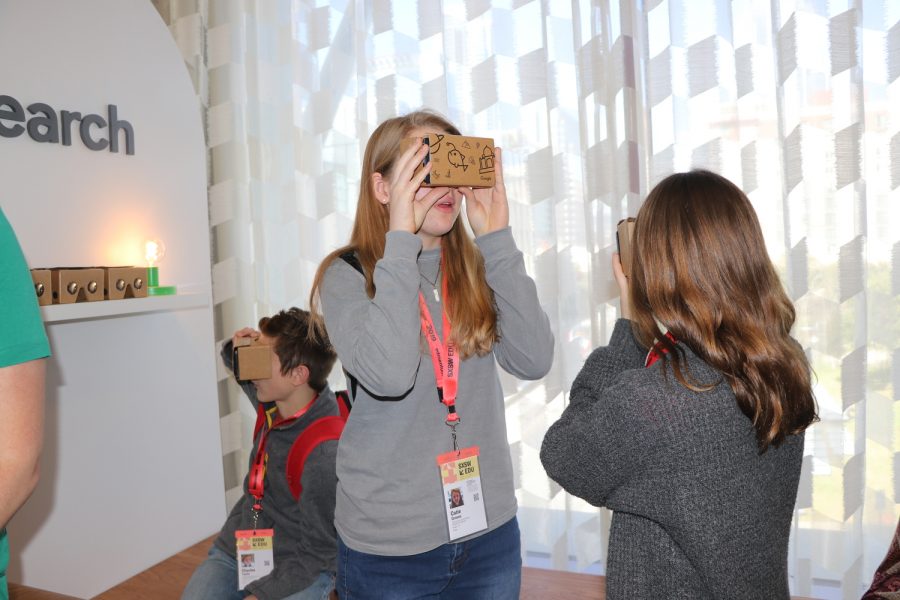SXSW Edu explores classroom possibilities of new AI, VR technologies
Sophomore Charles Taylor and freshmen Emma McBride and Catie Graves (left to right), Liberator staff writers, try on Google VR that depicted environmental causes. photo by adviser Kevin Garcia
April 9, 2019
Ray Bradbury’s Fahrenheit 451 takes place in a dystopian portrayal of future America where books are banned and any that are found are burned. Technology has taken over the lives of the people to such a degree that human interaction is severely impeded, and the history and memories of the people that came before them are up in smoke. Although nothing that drastic has happened at LASA, SXSWedu panel hosts debated on whether technology should play a key role in education, and if so, to what degree.
At SXSWedu there were panels, speeches and labs dedicated to the topic of artificial intelligence and technology in the classroom. Nesta, a U.K. based education charity which hosted a discussion at SXSWedu, released a report in February about the future of artificial intelligence in the classroom. This report, written by Toby Baker and Laurie Smith with Nandra Anissa, explores the potential of AI today, how it can be used in the classroom and how it can affect learning and education.
One of the largest interactive exhibits at SXSWedu was the Google Lab, which showcased some of Google’s newest features. Visitors used the Chat Bot, searched images and texts online with the explore feature and tried on the Google Cardboard, a VR device by Google. According to Melissa Horwitz, Google’s Education Marketing Manager, the company’s technology changes the structure of the traditional classroom.
“While teachers can’t knock down the four walls of their classroom they can rearrange what’s inside,” Horwitz said. “From the tables to the chairs and the devices that they’re using, whether it’s Chromebooks or Jamboards or anything else in a way that really facilitates collaboration among students, self-learning as well.”
A lot of Google’s devices and apps can be used in the classroom for learning and experience. Horwitz said this technology allows students to derive more enjoyment from learning, and helps them stay engaged throughout the day.
“If you make the lesson exciting for students and you engage with them, hopefully they’ll realize that they want to learn,” Horwitz said. “If they want to learn, they won’t be on Facebook in the middle of class, but they’ll wait until afterwards. It’s a potential challenge that teachers have today but our hope is that we can use technology for positive learning.”
Besides helping students pay attention during class itself, Horwitz said this different method of learning will benefit students beyond the K-12 space. According to Horwitz, solving problems using the software will affect their ability to address challenges throughout their adult lives.
“You can literally create your own expedition and teach other students about the issues with plastic in the ocean,” Horwitz said. “As opposed to a teacher potentially standing up in front of the class with a textbook open and saying this is a problem that exists today, so it’s just a different way of tackling real world challenges, and I think that the whole point is that in life, when you go to college, and when you go into the workforce, all of this is sort of how you’ll work, so its getting you guys ready for these ‘future skills’ as early as we can here in your learning journey.”
AI technology can also change the social dynamics in the classroom, both between the students and teacher and between the students themselves. Nancy Wilkinson, Nesta Programme Manager, said that AI can help personalize learning for each student, which might mean less collaboration in the classroom. However, Wilkinson also said that personalized learning could make things more efficient.
“On the other side of it, these technologies really help students work better with each other,” Wilkinson said. “It takes some of the more mundane tasks of the classroom and makes them more efficient, so they’ve got more time to work in a group with their teacher.”
The younger population of students appears to have a different opinion on this subject, not necessarily exclusive to AI, but more specific to technology as a whole. For instance, Nate Butkus, a second grader who is the host of a science podcast “The Show About Science.”
“[Technology] helps us learn more, and it pushes us to greater lengths,” said Butkus. “It touches pretty much every subject we do. In writing, we type our things out on computers. In reading, we sometimes read our books on computers.”
The topic of AI in the classroom will only continue to grow as technology becomes more and more advanced. Smith said AI is a tool that has to be used responsibly and sensibly.
“We think society needs to make responsible decisions about which way the technology goes and we need to make to choices now,” Smith said. “The choices you make today determine the outcome, we hope the right choices make a good outcome.”


